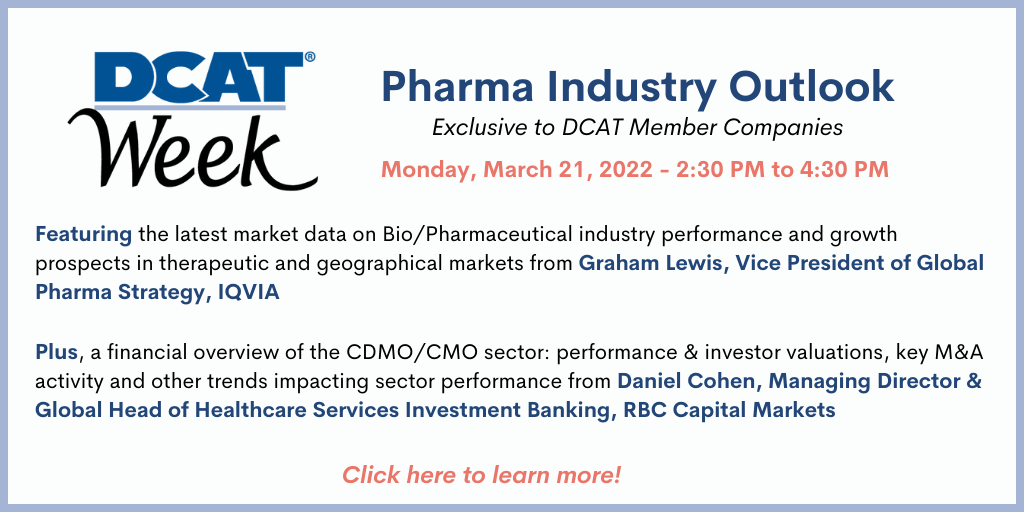Pharma Industry & CDMO Outlook: 2022 & Near Term
Will 2022 be a good year for the global Bio/Pharma industry? What factors are impacting growth? And how will the CDMO/CMO sector fare? A DCAT Week program provides an outlook for 2022 and near term.
Pharma industry outlook
A fundamental and crucial question is how the Bio/Pharmaceutical industry will perform in 2022 and the near term. While spending on COVID-19 vaccines and therapeutics contributed to overall global Bio/Pharmaceutical industry growth in 2021, how did non-COVID-19 product growth fare? Is growth returning to pre-pandemic levels and if so, what do the numbers show?


Vice President, Global Pharma Strategy
IQVIA
The DCAT Week education program, Pharma Industry Outlook, which will be held on Monday March 21 from 2:30 to 4:30 PM, will examine these issues. Graham Lewis, Vice President of Global Pharma Strategy, IQVIA, a business intelligence firm considered the gold standard for Bio/Pharmaceutical market analysis, will provide insight on the current and projected near-term performance of the Bio/Pharma industry. He will provide the latest market data and analysis for overall industry performance and delve deeper into the growth prospects for innovator and generic drugs, leading therapeutic areas, and developed & emerging markets.
Key to the industry’s overall performance will be how the US market fares. The US is the largest national market in the global Bio/Pharmaceutical industry with an approximate 40% share. In 2021, the US market grew modestly, and key to overall industry performance will be how the US market performs in the near term. Off-invoice discounts and rebates have cut into US market growth as has generic-drug incursion. A key issue going forward is whether innovator products, both in terms of new product launches and increased market penetration, can offset these downward pressures.
China, the second largest national market behind the US, will also play a key role in industry performance. Although still posting gains in 2021, growth slowed compared to historical levels. Whether a return to more robust growth is on the horizon will be an important development to consider in 2022 and the near term.
Other factors are influencing industry performance: macroeconomic uncertainty, supply-chain challenges, and evolving models in healthcare delivery. Mr. Lewis will examine these and other key factors at the Pharma Industry Outlook program, including shifts in product mix (small molecules and biologics) and the strength of the industry’s pipeline in driving product innovation.
Further information on the DCAT Week program, Pharma Industry Outlook, including how to register may be found here.

Managing Director & Global Head of Healthcare Services Investment Banking
RBC Capital Markets LLC
CDMO/CMO sector outlook
Bio/Pharmaceutical industry growth and pipeline progress are obviously large determinants of the health of the CDMO/CMO sector, but other variables influence the sector’s performance. Financial trends in the form of monies raised via venture capital, other private financing, and initial public offerings of emerging bio/pharma companies, an important customer base of CDMOs/CMO, also play a role. Other financial factors, such as inflationary pressures/margin squeeze and monetary policy/rising interest also impact the bottom line of CMDOs/CMOs.
So what can CDMOs/CMOs expect in 2022 and near term? The CDMO sector experienced a strong 2021, but the question for 2022 is whether momentum continues as macroeconomic headwinds create uncertainty. In 2021, strong performance and favorable market conditions contributed to a high level of mergers and acquisitions and strong company valuations in the CDMO/CMO sector, but what may 2022 hold? (1).
At the DCAT week program, Pharma Industry Outlook, Daniel Cohen, Managing Director & Global Head of Healthcare Services Investment Banking, RBC Capital Markets LLC, will provide answers. He will provide a financial overview of the CDMO/CMO sector: performance & investor valuations and analyze key M&A activity and other trends impacting sector performance.
Further information on the DCAT Week program, Pharma Industry Outlook, including how to register may be found here.
Reference
1. J. Miller, “CDMOs Ride Momentum into 2022,” DCAT Value Chain Insights, January 13, 2022.






